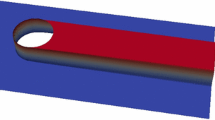Abstract
Residual diffusion in fluid-dynamics calculations results from the finite order of approximation in the underlying linear algorithm, including the effect of smoothing sometimes added for numerical reasons, and, in the case of monotonicity-preserving algorithms such as flux-corrected transport (FCT), the nonlinear action of the flux limiter on steep profiles. Some widely used FCT algorithms contain a multiplicative constant that reduces the antidiffusion coefficient by ∼0.01%–0.1%. Replacing this constant with a smoothly varying function of velocity which equals unity when the Courant number vanishes causes the linear diffusion to go to zero when the flow velocity does. The use of a velocity-dependent antidiffusion coefficient minimizes numerical smearing of discontinuities and associated effects in the neighboring flow. Computational examples are presented. The residual diffusion for nonzero flow speeds is nonlinear and problem dependent. A method is presented for calibrating it in any given code in the context of a particular problem, and is applied to the FCT algorithms described here.
Similar content being viewed by others
References
Book, D. L., Boris, J. P., and Hain, K. (1975). Flux-corrected transport: II. Generalizations of the method,J. Comput. Phys. 18, 248–283.
Book, D. L., and Fry, M. A. (1984). Airblast simulations using flux-corrected transport codes, in Noye, B. J., and Fletcher, C. A. J.,Computational Techniques and Applications, North-Holland, Amsterdam, pp. 826–840.
Boris, J. P. (1976). Flux-corrected transport modules for solving generalized continuity equations, NRL Memorandum Rept. No. 3237 (unpublished).
Boris, J. P. (1976a). Personal communication.
Boris, J. P. (1981). Appendix A in Book, D. L.,Finite-Difference Techniques for Vectorized Fluid Dynamics Calculations, Springer, New York.
Boris, J. P., and Book, D. L. (1973). Flux-corrected transport: I.Shasta—A fluid transport algorithm that works,J. Comput. Phys. 11, 38–69.
Boris, J. P., and Book, D. L. (1976). Flux-corrected transport: III. Minimal-error FCT algorithms,J. Comput. Phys. 20, 397–431.
Colella, P. (1983). Personal communication.
Grandjouan, N. (1990). The modified equation approach to flux-corrected transport,J. Comput. Phys. 91, 424–440.
Grinstein, F. F., and Guirguis, R. H. (1992). Effective viscosity in the simulation of spatially evolving shear flows with monotonic FCT models,J. Comput. Phys. (1992), in press.
Grinstein, F. F., Guirguis, R. H., Dahlburg, J. P., and Oran, E. S. (1989). Three dimensional numerical simulation of compressible, spatially evolving shear flows, inProc. 11th Int. Conf. Num. Meth. Fluid Dynamics, Springer, New York, pp. 283–287.
Grinstein, F. F., and Kailasanath, K. (1991). Chemical energy release, spanwise excitation, and dynamics of transitional, reactive, free shear-flows, AIAA-91-0247, Washington, D.C. (unpublished).
Grinstein, F. F., Oran, E. S., and Boris, J. P. (1990). Reinitiation and feedback in global instabilities of spatially developing mixing layers,Phys. Rev. Lett. 64, 870–873.
Li, C., and Book, D. L. (1991). Instability generated by acceleration due to rarefaction waves,Phys. Rev. A 43, 3153–3156.
Schlichting, H. (1987).Boundary Layer Theory, McGraw-Hill, New York.
Zalesak, S. T. (1979). Fully multidimensional flux-corrected transport algorithms for fluids,J. Comput. Phys. 31, 335–362.
Author information
Authors and Affiliations
Rights and permissions
About this article
Cite this article
Book, D.L., Li, C., Patnaik, G. et al. Quantifying residual numerical diffusion in flux-corrected transport algorithms. J Sci Comput 6, 323–343 (1991). https://doi.org/10.1007/BF01062816
Received:
Issue Date:
DOI: https://doi.org/10.1007/BF01062816




